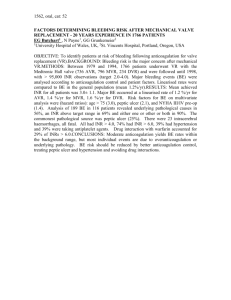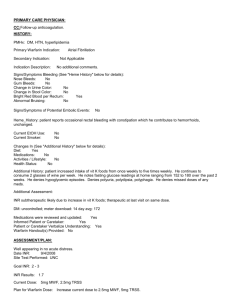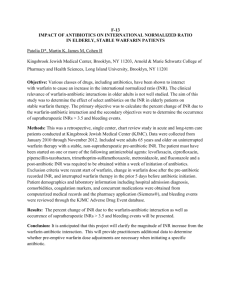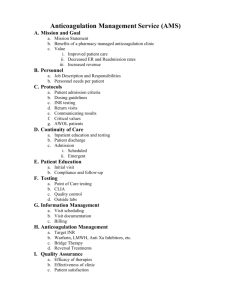Letter to the Editor vs. Anticoagulation services in Malta – an economic
advertisement
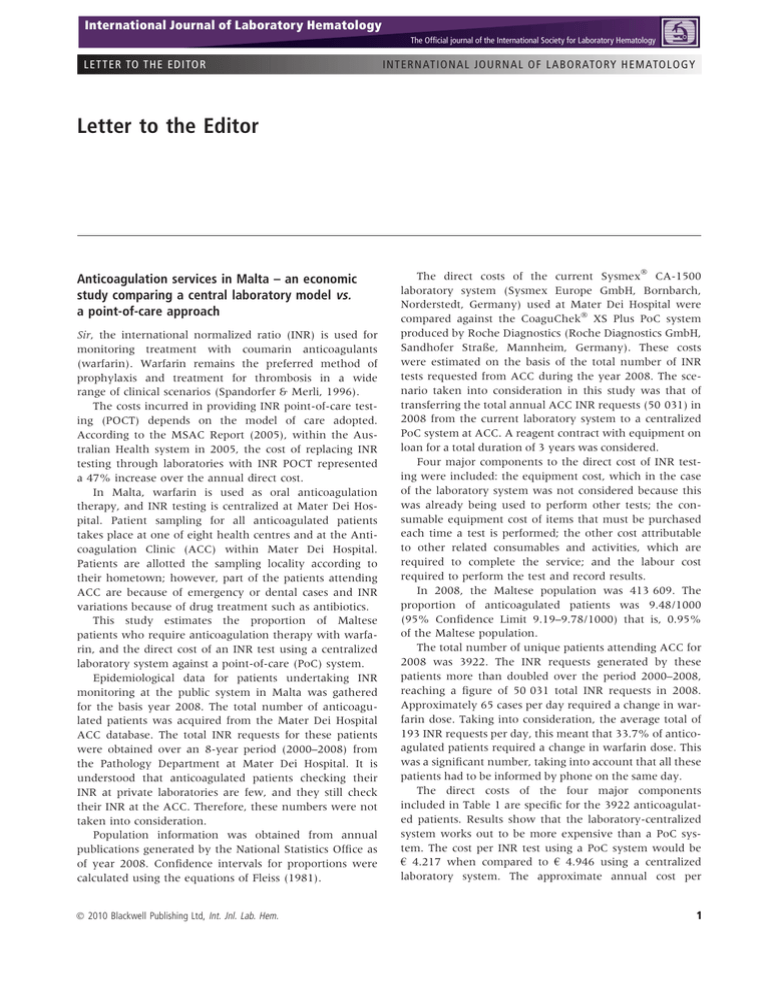
International Journal of Laboratory Hematology The Official journal of the International Society for Laboratory Hematology LETTER TO THE EDITOR IN TERN AT IO NAL JOU RN AL O F LABO RATO RY H EMATOLO GY Letter to the Editor Anticoagulation services in Malta – an economic study comparing a central laboratory model vs. a point-of-care approach Sir, the international normalized ratio (INR) is used for monitoring treatment with coumarin anticoagulants (warfarin). Warfarin remains the preferred method of prophylaxis and treatment for thrombosis in a wide range of clinical scenarios (Spandorfer & Merli, 1996). The costs incurred in providing INR point-of-care testing (POCT) depends on the model of care adopted. According to the MSAC Report (2005), within the Australian Health system in 2005, the cost of replacing INR testing through laboratories with INR POCT represented a 47% increase over the annual direct cost. In Malta, warfarin is used as oral anticoagulation therapy, and INR testing is centralized at Mater Dei Hospital. Patient sampling for all anticoagulated patients takes place at one of eight health centres and at the Anticoagulation Clinic (ACC) within Mater Dei Hospital. Patients are allotted the sampling locality according to their hometown; however, part of the patients attending ACC are because of emergency or dental cases and INR variations because of drug treatment such as antibiotics. This study estimates the proportion of Maltese patients who require anticoagulation therapy with warfarin, and the direct cost of an INR test using a centralized laboratory system against a point-of-care (PoC) system. Epidemiological data for patients undertaking INR monitoring at the public system in Malta was gathered for the basis year 2008. The total number of anticoagulated patients was acquired from the Mater Dei Hospital ACC database. The total INR requests for these patients were obtained over an 8-year period (2000–2008) from the Pathology Department at Mater Dei Hospital. It is understood that anticoagulated patients checking their INR at private laboratories are few, and they still check their INR at the ACC. Therefore, these numbers were not taken into consideration. Population information was obtained from annual publications generated by the National Statistics Office as of year 2008. Confidence intervals for proportions were calculated using the equations of Fleiss (1981). Ó 2010 Blackwell Publishing Ltd, Int. Jnl. Lab. Hem. The direct costs of the current SysmexÒ CA-1500 laboratory system (Sysmex Europe GmbH, Bornbarch, Norderstedt, Germany) used at Mater Dei Hospital were compared against the CoaguChekÒ XS Plus PoC system produced by Roche Diagnostics (Roche Diagnostics GmbH, Sandhofer Straße, Mannheim, Germany). These costs were estimated on the basis of the total number of INR tests requested from ACC during the year 2008. The scenario taken into consideration in this study was that of transferring the total annual ACC INR requests (50 031) in 2008 from the current laboratory system to a centralized PoC system at ACC. A reagent contract with equipment on loan for a total duration of 3 years was considered. Four major components to the direct cost of INR testing were included: the equipment cost, which in the case of the laboratory system was not considered because this was already being used to perform other tests; the consumable equipment cost of items that must be purchased each time a test is performed; the other cost attributable to other related consumables and activities, which are required to complete the service; and the labour cost required to perform the test and record results. In 2008, the Maltese population was 413 609. The proportion of anticoagulated patients was 9.48/1000 (95% Confidence Limit 9.19–9.78/1000) that is, 0.95% of the Maltese population. The total number of unique patients attending ACC for 2008 was 3922. The INR requests generated by these patients more than doubled over the period 2000–2008, reaching a figure of 50 031 total INR requests in 2008. Approximately 65 cases per day required a change in warfarin dose. Taking into consideration, the average total of 193 INR requests per day, this meant that 33.7% of anticoagulated patients required a change in warfarin dose. This was a significant number, taking into account that all these patients had to be informed by phone on the same day. The direct costs of the four major components included in Table 1 are specific for the 3922 anticoagulated patients. Results show that the laboratory-centralized system works out to be more expensive than a PoC system. The cost per INR test using a PoC system would be € 4.217 when compared to € 4.946 using a centralized laboratory system. The approximate annual cost per 1 2 LETTER TO THE EDITOR Table 1. Direct costs of international normalised ratio (INR) testing for a total contract duration of 3 years: Laboratory vs. point-of-care (PoC) system. Total number of tests = 150 093 Cost component Laboratory INR testing PoC INR testing Total equipment cost Total consumable cost Total other cost Total labour cost Repeats† Overall Total Unit cost per INR test € 0.00* € 32 000.00 € 63 439.94 € 639 622.00 € 7350.62 € 742 412.56 € 4.946 € 6400.00 € 479 940.24 € 2426.20 € 139 458.00 € 4787.97 € 633 012.41 € 4.217 *Total equipment cost = nil, because this was already being used for other tests. †Repeats = INR tests that had to be repeated because of an inappropriate sample. patient would be € 53.80 and € 63.10 for the PoC and laboratory system, respectively. As in developed countries (Murray & Greaves, 2003), Malta’s anticoagulated population is estimated at 0.95% of the total. This value is expected to increase because of an ageing population. At present, each patient encounter is based on a laboratory result, and an eventual telephone call should the warfarin dose needs to be altered. Wurster and Doran (2006) state that the changes that can be made to workflow by use of software decision support in combination with a point-of-care (PoC) device are wide ranging and important. The encounter is based on face-to-face contact rather than phone contact, thus improving communication, education and patient satisfaction (Wurster & Doran, 2006). The pharmacist plays a vital role within this workflow including performing the test, interpreting the result, making the necessary adjustments using the appropriate software, dispensing warfarin and advising the patient. This is applicable both in a hospital and in a community set-up. Given that there is no equipment cost associated with laboratory INR testing in the context of this study, the References Caffee A.E. & Teichman P.G. (2002) Improving anticoagulation management at the Point of Care. Family Practice Management 2, 35– 37. Fleiss J.L. (1981) Statistical methods for rates and proportions. Wiley, New York. cost of labour is likely to be the main component of the total direct cost of laboratory testing. The centralized laboratory-based INR system in use is time-consuming and labour intensive. The cost of replacing INR testing through a centralized laboratory system with INR PoC testing represents a 17.30% decrease over the annual direct cost of INR testing through the laboratory. There are various potential advantages of INR PoC testing compared to laboratory testing. These include availability of the INR level at the same time as the clinical consultation; improved compliance with warfarin; direct face-to-face consultation about suggested changes to warfarin therapy, rather than management changes suggested over the telephone; if INR levels are high, and especially if a haemorrhagic event is occurring, the immediate availability of INR testing may result in more appropriate management of the event; increased convenience for the patient, particularly if living some distance from phlebotomy services; and overcoming difficulties of frequent venepuncture, which is particularly advantageous in paediatric populations (MSAC Report, 2005). PoC devices allow anticoagulation management that is convenient for patients and physicians. In a single office visit, history is updated, a physical examination is performed and, with one fingerstick, INR is accurately measured. The entire care transaction can be completed in a fraction of the time it would take to draw and process a blood sample following a traditional laboratory set-up (Caffee & Teichman, 2002). The pharmacist’s intervention in managing oral anticoagulation therapy is imperative to ensure that the patient receives the most appropriate approach. Gordon Zammit, Ryan Farrugia, Chris Barbara, Lilian Azzopardi, Anthony Serracino Inglott, Maurice Zarb Adami, Victor Grech Pharmacy Department, University of Malta, Msida, Malta E-mail: gordonzammit@viviancorp.com doi: 10.1111/j.1751-553X.2010.01279.x MSAC Report. (2005) The Use of INR point-ofcare testing in general practice. MSAC application 1071. Assessment Report. Australia, 21–22. Murray E.T. & Greaves M. (2003) INRs and point of care testing. BMJ 327, 5–6. National Statistics Office. (2008) Demographic Review of the Maltese Islands. Annual Publication. Spandorfer J.M. & Merli G.J. (1996) Outpatient anticoagulation issues for the primary care physician. Medical Clinics of North America 80, 475–491. Wurster M. & Doran T. (2006) Anticoagulation management: a new approach. Disease Management 9, 206. Ó 2010 Blackwell Publishing Ltd, Int. Jnl. Lab. Hem.
